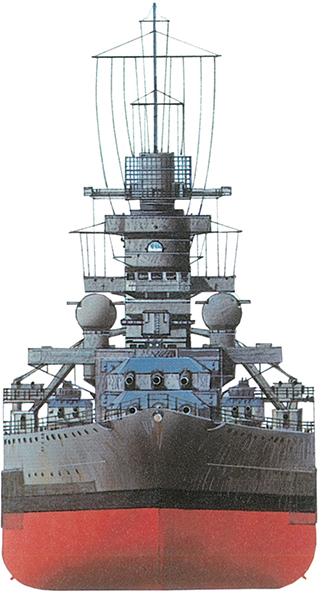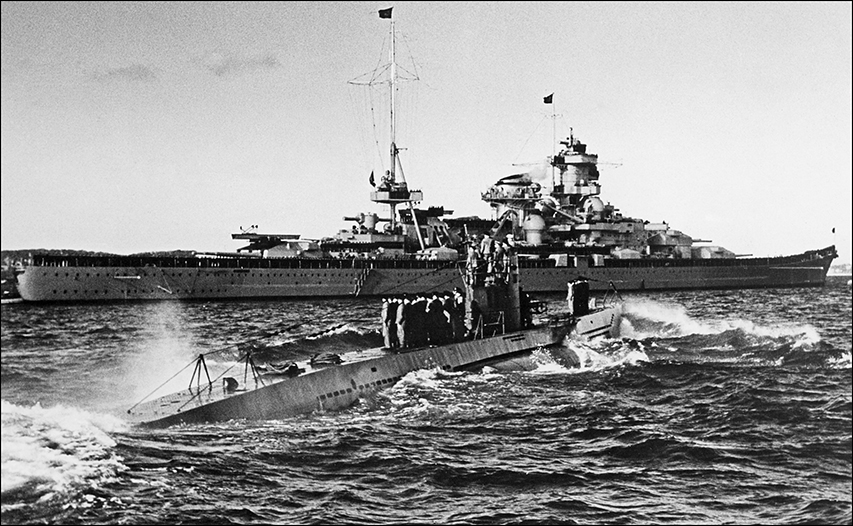 Scharnhorst (1939)
Scharnhorst (1939) Scharnhorst (1939)
Scharnhorst (1939)Often referred to as the first German battleship to be constructed since World War I, Scharnhorst, the first of the two to be launched, was actually laid down and commissioned after Gneisenau. Though sister-ships, there were numerous minor differences.
Scharnhorst was laid down at the Kriegsmarinewerft, Wilhelmshaven, on 16 May 1935, launched on 3 October 1936 and completed on 7 January 1939. Its cost was 143,471,000 Reichsmarks. Almost immediately in July–August 1939 its bow was rebuilt to ‘Atlantic’ form. Armament, armour and machinery were essentially the same as Gneisenau’s, though Scharnhorst had Brown-Boveri rather than Germania turbines. The three propellers were triple-bladed, with a diameter of 4.45m (14ft 6in) and Scharnhorst’s speed of 58.6km/h (31.64 knots) gave it a distinct edge over the British King George V class, whose maximum was 54km/h (29.2 knots).

As commerce raiders, Scharnhorst and Gneisenau showed deadly effectiveness, sinking 22 merchant ships between 22 January and 23 March 1941. On three occasions British battleships were sighted but avoided. Scharnhorst covered an average of 548km (296nm) a day.
The hull was built of ST 52 steel, and a new steel armour was introduced, known as type Wh, with a tensile strength of 85–95 kg/mm2, and Ww (65–75 kg/mm2). Apart from their resistant qualities, these steels could be welded, with important advantages in construction speed and weight-saving. Nevertheless, the two ships would ultimately displace over 27,215 tonnes (30,000 tons).

Belt armour had a maximum thickness of 350mm (13.8in), which might be expected to hold against a 356mm (14in) shell, and the armoured deck was 105–20mm (4–0.79in) thick. The armour weighed considerably more than the actual hull at 12,706 tonnes (14,006 tons) compared to 7469 tonnes (8233 tons). But both ships would survive heavy attacks from shells, torpedoes and bombs.
From 1941 Scharnhorst was fitted with 12 quadruple-mounted 20mm (0.79in) AA guns. From early 1939 Gneisenau had a mainmast attached abaft the funnel, and Scharnhorst originally had a taller mainmast in the same position but free-standing, though with the searchlight platform built out round it from the funnel casing. In the July–August 1939 alterations, this was changed to a tripod and moved sternwards to a position just forward of the aft control tower.
Operation Cerberus
Operation Cerberus was carried out at Hitler’s order. Preparations included minesweeping operations along a deep water route to ensure high-speed movement. Six destroyers, 14 T-boats and three motor torpedo boat flotillas were assembled, and the Luftwaffe deployed 250 fighter planes. The intention was known to British naval intelligence but the German squadron was expected to pass through the Straits of Dover by night. Its daytime passage on 12 February, at 50km/h (27 knots) took the British by surprise, and their preparations for attack were insufficient and effectively repelled by the German ships and planes. The mines hit by Scharnhorst and Gneisenau had been laid by aircraft along the anticipated route. The operation was an undoubted success for Germany, but the strategic background was one of retreat and withdrawal. Hitler was not prepared to risk the capital ships in the Atlantic, and for the rest of the war their role was a limited one.
Specification
Dimensions |
Length 235m (772ft), Beam 30m (98ft 5in), Draught 9.7m (31ft 9in), Displacement 29,121 tonnes (32,100 tons), 34,564 tonnes (38,100 tons) full load |
Propulsion |
12 Wagner HP boilers, 3 Brown-Boveri geared turbines developing 119,312kW (160,000hp) |
Armament |
9 280mm (11in) guns, 12 150mm (5.9in) guns, 14 105mm (4.1in) guns, 16 37mm (1.5in) and 10 20mm (0.79in) AA guns, 6 533mm (21in) torpedo tubes |
Armour |
Belt 350–200mm (13.8–7.9in), Bulkheads 200–150mm (7.9–5.9in), Deck 50–20mm (2– 0.79in), Barbettes 350–200mm (13.8–7.9in), Turrets 350–200mm (13.8–7.9in), Conning tower 350–100mm (13.8–3.9in) |
Range |
18,500km (10,000nm) at 17 knots |
Speed |
31 knots |
Complement |
1968 |
Searchlight and radar platforms were mounted, making the clearest difference between the two ships. Both had pole foremasts attached to the main tower. Scharnhorst also received an inclined funnel cap.
Originally a second catapult had been installed on the after turret in both ships, with a folding crane mounted on the port side, but this was removed before the end of 1939. At the same time a boom-mounted canvas landing device that could be swung out from the port side was removed. The aircraft carried were three Arado Ar196A-3 (Gneisenau for a short time had Heinkel He-114 planes). Range-finding and radar equipment was updated through 1940–42, and by 1942 it had FuMO 27, FuMB1, FuMB 4 SAMOS, FuMB7 and FuMB3 systems installed.
Germany had been working on radar development from 1934 but the systems available in 1943 were less sophisticated than those brought into use by the British and Americans. Five searchlights, triaxially stabilised and operated by a central control station, were fitted.
In the operations off Narvik in April–June 1940, Scharnhorst was first to open fire on the carrier HMS Glorious, which was sunk. A torpedo from HMS Acasta made a 12 by 4m (38ft by 13ft) gash in the battleship’s side and around 2268 tonnes (2500 tons) of water were shipped. At slow speed it made for Trondheim for emergency repairs. Air attacks on it during 10–13 June were a failure, and Scharnhorst was able to return to Kiel for full repair. It remained at Kiel until 22 January 1941, then was based at Brest for the commerce raids of January–March which (with Gneisenau) accounted for over 95,254 gross tonnes (105,000 gross tons) of Allied merchant shipping.

Deck plan: the 150mm (5.9in) secondary guns are clearly visible from this perspective, as are the many smaller 37mm (1.5in) and 20mm (0.79in) AA guns.
In the ‘Channel dash’ from Brest to Germany between 11 and 13 February Scharnhorst struck two mines, the first of which immobilised the ship for 17 minutes, but it made Wilhelmshaven under its own steam. Repaired again at Kiel, Scharnhorst joined with Tirpitz in bombarding Spitzbergen on 6–8 September 1943. By the end of that year it was the Reich’s only operational capital ship. With a force of five destroyers under Rear Admiral Bey, it was sent on 25 December to attack Convoy JW55B en route for Murmansk. In Arctic waters north of North Cape, after an inconclusive encounter with the British cruisers Norfolk, Belfast and Sheffield, Scharnhorst came under fire from the radar-directed 356mm (14in) guns of the battleship Duke of York, with four escorting destroyers. A combination of torpedoes and shell-fire at increasingly close range finally destroyed Scharnhorst, which continued firing from the one surviving turret to its last moments. Its bow was blown off, and it sank at 19:44 on 26 December, in 290m (950ft) of water, with the loss of 1803 men.

Scharnhorst’s crew salutes that of U-47 as it returns to Kiel after sinking HMS Royal Oak in September 1939.